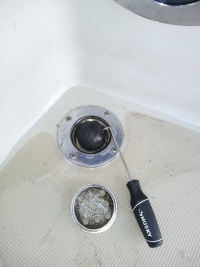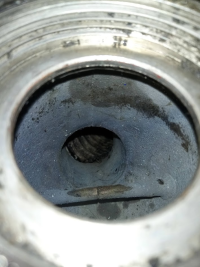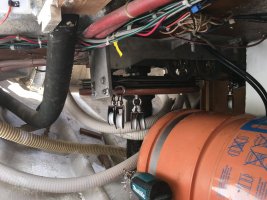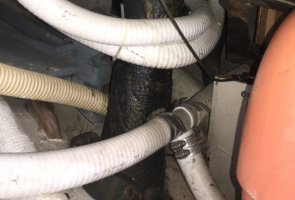Jerry VB
E32-3 / M-25XP
On my '89 E32-3 there are two cockpit drains that go to a through hull under the sink that is below the waterline (with a seacock) and two that go directly to a through hull each with no seacocks. The latter two drains are in the corners of the cockpit. This is common on the Ericsons of that vintage and hull style.
If I close the seacock under the sink and it rains, I come back to the boat to find standing water in the cockpit. The "direct - above water" drains are not draining. That makes me very unhappy because I don't like leaving seacocks open.
This past weekend I dug into the issue. It looks like the direct cockpit drains (in the corners of the cockpit) are Perko "Cockpit Scupper 0142" (1.5" hose connection - the picture on the Perko site is the 1" version).
Since I did not have a spanner style deck key (in fact I did not know that was what I needed), I made a low budget spanner wrench:

The drain unscrewed with no fuss. Inside I found a rubber check ball. On one drain it was still stuck shut; on the other, it must have dislodged at some point. The rubber check balls are one of those things that work really well in your mind but less well in real life... especially after 30 years of exposure.
This is the "unstuck" check ball:

It is difficult or impossible to remove them nondestructively since they "pop" in and there isn't a good way to push them back out. Theoretically I could have removed the hose and pushed it out from the back side, but I spent the previous weekend in the aft lazerette disconnecting one hose to verify the hose wasn't clogged. I had no intention of spending another weekend down there.
Since I was very unhappy with the balls already, I stabbed them with a 90 degree hose remove tool (Home Depot) and yanked them out from the top.

What the drains look like after their balls have been removed:

The balls are 1.6" in diameter:

We went sailing after the ballectomy. It was pretty calm with ~1 foot waves. A little water splooshed up when a wave hit just right but the water went right back down the drain. No significant water in the cockpit due to the missing balls.
It turns out the check balls are available as replacement parts (e.g. from West Marine). I ordered two and will update this entry with my evaluation after sailing without and with the balls a few times.
If I close the seacock under the sink and it rains, I come back to the boat to find standing water in the cockpit. The "direct - above water" drains are not draining. That makes me very unhappy because I don't like leaving seacocks open.
This past weekend I dug into the issue. It looks like the direct cockpit drains (in the corners of the cockpit) are Perko "Cockpit Scupper 0142" (1.5" hose connection - the picture on the Perko site is the 1" version).
Since I did not have a spanner style deck key (in fact I did not know that was what I needed), I made a low budget spanner wrench:

The drain unscrewed with no fuss. Inside I found a rubber check ball. On one drain it was still stuck shut; on the other, it must have dislodged at some point. The rubber check balls are one of those things that work really well in your mind but less well in real life... especially after 30 years of exposure.
This is the "unstuck" check ball:

It is difficult or impossible to remove them nondestructively since they "pop" in and there isn't a good way to push them back out. Theoretically I could have removed the hose and pushed it out from the back side, but I spent the previous weekend in the aft lazerette disconnecting one hose to verify the hose wasn't clogged. I had no intention of spending another weekend down there.
Since I was very unhappy with the balls already, I stabbed them with a 90 degree hose remove tool (Home Depot) and yanked them out from the top.

What the drains look like after their balls have been removed:

The balls are 1.6" in diameter:

We went sailing after the ballectomy. It was pretty calm with ~1 foot waves. A little water splooshed up when a wave hit just right but the water went right back down the drain. No significant water in the cockpit due to the missing balls.
It turns out the check balls are available as replacement parts (e.g. from West Marine). I ordered two and will update this entry with my evaluation after sailing without and with the balls a few times.
Last edited:



